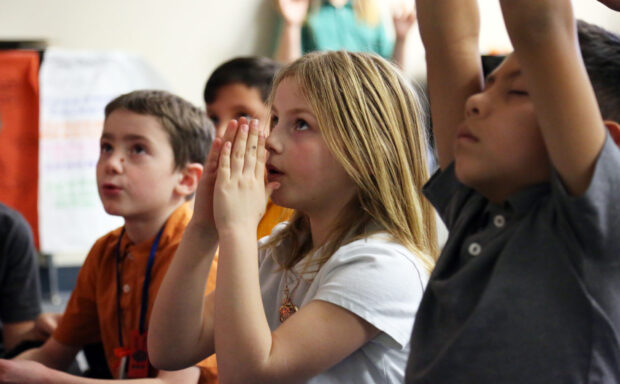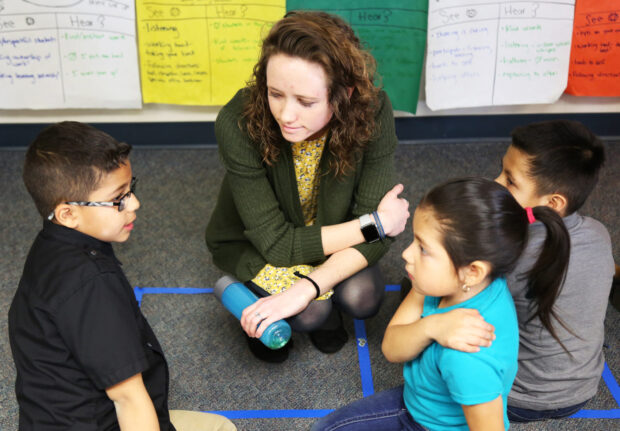CALDWELL — Abuse. Bullying. Divorce. Neglect.
Some students bring these experiences to school from home, which they can’t get out of their brain and truly focus on their learning.
Angela Layne is no stranger to working with students who have experienced trauma. The Lewis and Clark Elementary counselor is changing the way students’ express feelings at school.
She introduced trauma-informed practices to Lewis and Clark Elementary staff and students five years ago. This involves understanding, recognizing and responding to the effects of all types of trauma within kids.
“I want to build resiliency in the students by continuing to support and grow the positive culture and climate in the staff,” Layne said, a counselor at Lewis and Clark Elementary. “Trauma-informed is what’s right for students.”
Discipline issues have dropped at the school since using trauma-informed practices. Discipline handled by an administrator decreased 17 percent and teachers are handling more situations in the classroom.
“This is fantastic,” said Leigh Peebles, the principal at Lewis and Clark Elementary. “Kids can’t just set traumatic incidents aside. We need to create a safe emotional environment before we can even talk about academics.”
Trauma-informed approach
Trauma-informed is based on the idea that students who misbehave may be the result of a brain that has been overwhelmed by repeated traumatic experiences.
It’s about teachers establishing a bond with students, creating a safe environment for them in the classroom and facilitating sensory-based soothing activities, like allowing a student to stretch next to their desk, do breathing techniques or take a walk and talk through their struggles.

Cassie Doxtator’s second-grade class often takes five-minute breaks from math to work on deep breathing techniques.
Breathe in, breathe out … now take a deep breath. The students pair up to ask each other how they’re feeling.
“At first I thought the students would think this approach would be silly, but I was wrong,” Doxtator said. “Students remind me to do some breathing during the day.”
Doxtator asks the class if everyone is in their upstairs brain — meaning your brain is functioning well with emotions. Suddenly a student raises her hand flipping four fingers up — she just “flipped her lid” and is in her downstairs brain. Flipping the lid means the student is feeling intense and not able to access the logical, problem-solving part of the brain.
When students give the “flip the lid” hand signal they go to a calming place in the classroom. This area can include a yoga mat, glitter jar or artwork on the wall. This allows students to go into a calm mode and get back into a focused learning environment.

“This area visually prompts students through a breathing activity, progressive relaxation technique or a guided thought process,” Layne said.
Trauma-informed teaches students about their emotions. Starting in kindergarten students learn the connections between feelings and behavior, while older students learn the biology and management of stress response.
This year, students and teachers are learning about the power of mindfulness and how to incorporate it into the school day. Students are learning the different functions of the brain, which can trigger the downstairs and upstairs brain psychologically and physiologically.
“This is a culture in our classrooms,” Layne said. “Students are more aware of their feelings.”
The cost of a trauma-informed school for Lewis and Clark Elementary are minimal — supplies for calming places in the classroom, such as yoga mats and wall art. Layne attends workshops and does most of the research herself for staff trainings.
“We arent going to do something just to say it,” Layne said. “It has to be meaningful and researched-based, and so far this is working for us.”
Results
With discipline numbers down, Peebles also believes trauma-informed practices are promoting academic success. Kindergarten through third-grade students who take the Idaho Reading Indicator (IRI) twice a year to measure growth and proficiency in reading are trending upward.
In the fall of 2016, 19 percent of kindergartners scored at grade level. At the end of the school year, 90 percent of those same children scored at grade level. In the fall of 2016, 36 percent of third-graders scored at grade level. Those same third graders scored 48 percent in the Spring of 2017.
One hundred percent of Lewis and Clark Elementary students qualify for free and reduced lunch and 14.7 percent of the students are English language learners.
“We are seeing incredible results,” Peebles said.
